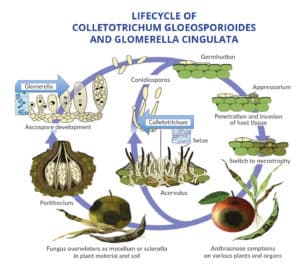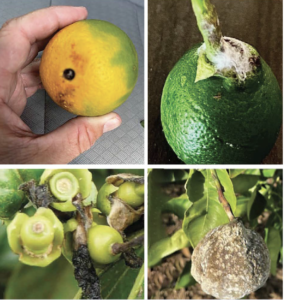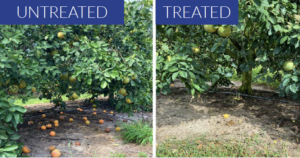A Major Cause of Fruit Drop May be a Familiar Foe — But Not the One You Think
Research is pointing to the sexual phase of Colletotrichum gloeosporioides — the fungus that causes anthracnose.
It has been assumed that HLB (huanglongbing or citrus greening) is the biggest cause of fruit drop. The disease causes stress in tree roots and disrupts the uptake of nutrients through the phloem. Why wouldn’t it cause fruit to drop since a stressed tree can only support so much fruit? However, sometimes what seems obvious may just distract from the real cause. Scientists at KeyPlex are exploring an entirely new hypothesis on the cause of fruit drop, and they have good reason to think they are onto something. The early Glomerella research findings were a topic at the KeyPlex Symposiums in September 2021 and February 2022, along with possible solutions.
 It Started with Coffee
It Started with Coffee
In 2016 Mauricio Flores, researcher at KeyPlex, was working with BASF in Costa Rica to identify the cause of fruit drop on a coffee plantation. Nearly 50% of the beans were dropping to the ground, and there was significant twig dieback. Flores isolated a fungus — Glomerella cingulata — from samples, and determined it was widespread throughout the trees. He developed a fungicide program — which now includes KP-120 — to control the fungus, and fruit drop and twig dieback were reduced dramatically. Fast forward to June 2021. Flores was sampling hundreds of citrus trees in groves across Central Florida and had a feeling of déjà vu. “Had I seen this before in a different crop?” he says. He had once again isolated Glomerella cingulata from the samples and noticed the same symptoms of fruit drop and twig dieback. G. cingulata is the sexual phase of a pathogen that may already be familiar to growers as the cause of anthracnose — Colletotrichum gloeosporioides.
“We started hypothesizing that Glomerella cingulata was the main cause of fruit drop in citrus, not HLB, as has been long presumed,” says Gerald O’Connor, CEO of KeyPlex. “We scoured the world looking for information on this, and came across Dr. Vladimiro Guarnaccia, who co-authored a paper on it — a study that took 11 years and looked at citrus across the Mediterranean basin — at the University of Torino. We are partnering with Vladimiro going forward to conduct detailed studies on C. gloeosporioides and G. cingulata and how they may impact fruit drop in citrus.”
Research Involves Partnership with Growers

The pathogen was identified as Glomerella cingulata (Colletotrichum
gloeosporioides) having pink, white, grayish colonies, with septated,
brownish mycelium with typical structures of the species.
O’Connor is grateful for the support his team has already received from citrus growers. “We’ve traipsed through so many fields and taken hundreds of samples in Florida in the last two years trying to ascertain levels of severity of G. cingulata in groves,” he says. “Nearly everyone we’ve asked has let us take samples. We are ready to get back to growers with the results and continue to dig deeper into the epidemiology of this fungus.”
During the next phase of research, Flores (in Florida) and Guarnaccia (in Italy) will try to isolate either C. gloeosporioides or G. cingulata from fruit to complete the picture. They will also evaluate the effect of environmental conditions, variety and rootstock selection, sources of inoculum, the role of HLB as a potential triggering mechanism, possible insect vectors, and patterns of spread. The KeyPlex team will collaborate and share information, and O’Connor’s aim is to continue to communicate regularly with citrus growers on the results.

Glomerella cingulata has been isolated from the calyx, peduncle, and fruit cuticle. It is hypothesized to be a major cause of fruit drop in citrus.
Heath Prescott, Senior Technical Sales Representative at KeyPlex, says he and Flores are looking at chemistries that already exist and are registered in Florida, along with new molecules.
“We feel the sense of urgency that citrus growers have…”
Prescott says. “We have to open every door and see what’s behind it, whether big or small. Yes, greening may be a major cause of fruit drop. But it may be just magnifying a problem that is already there. Either way, as of now, there is no cure for greening. So, if we can find another way to prevent fruit drop, we want to find it.”

Fruit drop was significantly reduced when managed
correctly with KeyPlex 120+ various fungicides.
Prescott says there has been such a focus on greening in the last 15 years that some farming practices, for a number of reasons, have been set aside, including fungicidal applications. “Between cost and lack of production, they’ve been taken out of programs, and that’s about the time we started seeing significant fruit drop. It was attributed to greening, but maybe we just weren’t taking care of the obvious,” he says. O’Connor says the answer to fruit drop may have been there all along, but nobody was looking for it.
“We think we’re onto something and are excited to share our development with citrus growers,” O’Connor says. “We’re committed to the Florida citrus industry, and optimistic for its recovery.”
Find out how KeyPlex can help. Contact your local KeyPlex sales representative or visit KeyPlex.com for more information.
